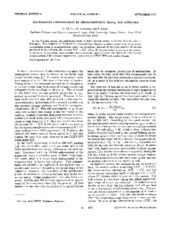| dc.creator | Ko, Che Ming | |
| dc.creator | Asakawa, M. | |
| dc.creator | Levai, P. | |
| dc.date.accessioned | 2011-09-13T21:25:49Z | |
| dc.date.available | 2011-09-13T21:25:49Z | |
| dc.date.issued | 1992 | |
| dc.identifier.citation | Che Ming Ko, M. Asakawa and P. Levai. Phys.Rev.C 46 1072-1076 1992. "Copyright ( 1992) by the American Physical Society." | en |
| dc.identifier.uri | http://dx.doi.org/10.1103/PhysRevC.46.1072 | |
| dc.identifier.uri | https://hdl.handle.net/1969.1/126825 | |
| dc.description | Journals published by the American Physical Society can be found at http://publish.aps.org/ | en |
| dc.description.abstract | In the Walecka model, the antilambda mass in dense nuclear matter is smaller than its value in free space. This reduces the threshold for antilambda production in dense matter that forms in the compression stage of ultrarelativistic heavy ion collisions. Because of the large number of mesons produced in the collision, the process KM --> LAMBDA-BAR N, where M denotes either a pion or a rho meson, is shown to be important and provides thus a plausible explanation for the observed enhancement of antilambda yield in recent experiments carried out at CERN SPS with nuclear beams. | en |
| dc.language.iso | en | |
| dc.publisher | American Physical Society | |
| dc.subject | Physics | en |
| dc.title | Antilambda Enhancement in Ultrarelativistic Heavy-Ion Collisions | en |
| dc.type | Article | en |
| local.department | Physics and Astronomy | en |


